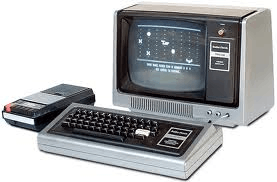TRS-80

The other big brand-name home computer of the late 1970s, besides the Apple II and the VIC 20.
The TRS-80 -- short for Tandy Radio Shack Z-80 -- was Radio Shack's entry into the consumer microcomputer market. The first version offered, known as the Model 1, had a black-and-white display with character mode graphics, and could not support a disk drive or more than 16K of memory without adding on a special "expansion interface" that normally sat beneath the monitor.
Since the keyboard was built into the CPU cabinet -- indeed, in the case of the Model 1, the keyboard was the CPU cabinet -- it was impossible to change out your keyboard if it went bad. This made the keyboard's susceptibility to "keybounce" paarticcullarlllly annnnoyyyingg. This and other "features", such as the absymally low resolution graphics, led many of its detractors to refer to the computer as the TRaSh-80.
Versions
Model 1
- Z-80 CPU running at 1.77 MHz
- CPU inside keyboard
- Maximum of 16K RAM without the expansion interface, 48K with.
- Level I BASIC, which fit entirely within 4K of ROM, capable of loading in data and programs off cassette at 250 bits per second.
- Level II BASIC, capable of loading in data and programs off cassette at a blistering 500 bits per second.
- 128x48 graphics implemented with special upper-ASCII graphics characters (6 giant rectangular pixels per character)
- Add-on 5.25" floppy drives, available if the unit had an Expansion Interface installed.
- "Supported" audio output, in the sense that software could ask the user to plug the cassette tape drive plug into a speaker when not loading data.
Model 2
- Z-80 CPU
- Built-in 8" (yes, eight-inch) floppy drive.
- Never terribly popular, as its internal memory map was not software-compatible with the Model 1.
Model 3
- Basically, a Model 1 with floppy drives and an expansion interface built into the cabinet.
- Slightly different ROM, though.
- Could load data from cassette tape at a mind-numbing 1500 bits per second.
- Mostly, but not entirely, software-compatible with the Model 1.
- Since the video display took its power from the same power supply as the floppy drives, the image on the display could noticeably shrink during disk access.
Model 4
- Successor to the Model 3. Backward compatible.
- Had an optional "high resolution" monochrome graphics mode of up to 640x240 pixels, if you added hardware.
Model 16
- Follow-on to the Model 2.
- Kept the Z-80 CPU as an I/O processor only.
- Main CPU was a 6 MHz 16-bit -- yes, 16-bit! -- Motorola 68000, the same CPU that would later appear in the Apple Macintosh.
Color Computer
- Only TRS-80 not to be limited to a black-and-white display. Its output was designed to be shown on an ordinary color TV set.
- Also the only TRS-80 not to use a Z-80 CPU. Its architecture was instead built around a Motorola 6809.
- Also the only TRS-80 to have built-in support for generating sound.
- Completely incompatible with software written for any other TRS-80 model.
- Was able to run a UNIX clone called OS-9 instead of Microsoft's Disk Extended Color BASIC as its operating system.
Appearances
Comic Books
- Radio Shack teamed up with DC Comics to produce comics featuring mainstream DC superheroes and the "TRS-80 Whiz Kids". Said Whiz Kids would use their TRS-80s to help Superman, Supergirl, and Wonder Woman save the world, usually by doing things like converting Fahrenheit to Celsius. Atop the Fourth Wall reviewed two of these comics.